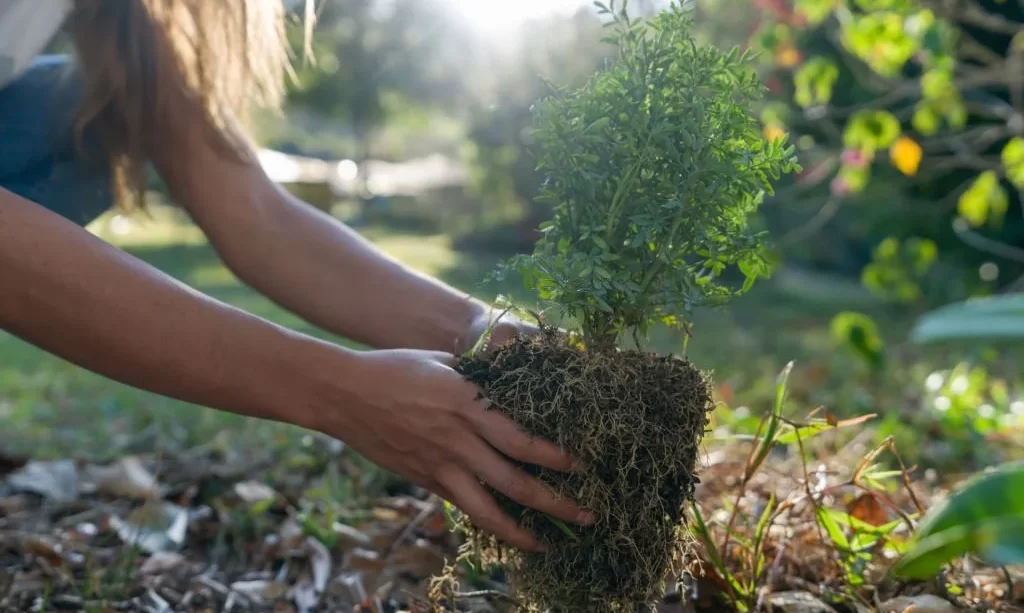When it comes to landscaping and gardening, timing is often the key to success. This holds especially true for planting shrubs, where the right timing can make all the difference in the growth and vitality of your landscape. But when should you plant shrubs? Is it best to do so in the freshness of spring or the crispness of fall? In this guide, we’ll explore the optimal timing for planting shrubs, discussing the advantages and considerations of both spring and fall planting. By understanding the seasonal nuances, you’ll be better equipped to create a thriving and beautiful landscape.
- Fortified with phosphorus and iron
- Moisture Control protects against over- or under-watering
- Feeds up to 3 months
- Builds strong roots
- For in-ground use only
Spring Planting
Spring, with its mild temperatures and rejuvenated soil, presents an ideal opportunity to plant shrubs. Here’s why:
- Mild Conditions: Spring brings moderate temperatures that are conducive to root development without the stress of summer heat. This allows newly planted shrubs to establish themselves comfortably.
- Moist Soil: The winter months often saturate the soil, providing a moisture-rich environment that is advantageous for shrub root growth. Spring planting takes advantage of this soil moisture.
- Plant Health: Shrubs planted in the spring have the entire growing season ahead to develop robust root systems and foliage, which prepares them for winter.
Spring planting is particularly well-suited for shrubs that thrive in temperate conditions and deciduous varieties that benefit from a full growing season to establish themselves.
Fall Planting
Contrary to what you might expect, fall is also an excellent time to plant shrubs. Here’s why many gardeners opt for autumn planting:
- Cooler Temperatures: As the summer heat subsides, the cooler fall temperatures reduce the stress on newly planted shrubs, allowing them to establish roots without the risk of overheating.
- Moisture Availability: Fall typically brings increased rainfall, which helps newly planted shrubs settle into the soil. This extra moisture aids in root development.
- Reduced Competition: By planting in the fall, you’re giving your shrubs a head start over weeds and competing plants that often sprout vigorously in the spring.
Fall planting is advantageous for shrubs that are more resilient to winter conditions and for gardeners who prefer to get a jump on their landscaping projects before winter arrives.
Understanding the benefits of both spring and fall planting allows you to choose the best timing for your specific shrub species, local climate, and personal gardening preferences. Whether you prefer the freshness of spring or the tranquility of autumn, planting shrubs at the right time ensures your landscape thrives year-round.
Winter Planting (In Mild Climates)
While winter might seem an unlikely time for planting shrubs, it’s worth mentioning that in mild climates, it can be a viable option. Here’s why:
- Mild Winters: In regions with mild winters, where freezing temperatures and snowfall are rare, the soil remains workable during the winter months. This makes it possible to plant shrubs without exposing them to extreme cold.
- Reduced Competition: Winter is a season of dormancy for many plants, which means less competition for resources like sunlight and soil nutrients. This can be an advantage for newly planted shrubs.
- Winter Rains: Some areas experience increased rainfall during the winter, providing ample moisture for newly planted shrubs to establish their roots.
However, it’s crucial to note that winter planting in mild climates is not universally suitable for all shrub species. Careful consideration of the shrub’s hardiness and local climate is essential to avoid any potential winter damage.
Avoiding Extreme Temperatures
Regardless of the planting season, it’s imperative to avoid extremes in temperature. Planting shrubs during the peak of summer heat or the harsh cold of winter can stress the plants and hinder their establishment. Instead, aim to plant during milder periods when the soil is workable and temperatures are moderate. This reduces the risk of transplant shock and increases the chances of success.
Specific Timing for Shrub Varieties
Different shrub species have varying preferences when it comes to planting timing. Here’s a brief overview of when to plant common shrub categories:
- Evergreens: Evergreen shrubs are often best planted in the spring or early fall, giving them ample time to establish their roots before the harsh conditions of winter.
- Deciduous Shrubs: Many deciduous shrubs thrive when planted in the spring, taking advantage of the full growing season to establish themselves. However, fall planting can also be suitable for certain deciduous varieties.
- Flowering Shrubs: Timing for flowering shrubs can vary based on the specific species. Some bloom on new growth, making them well-suited for spring planting, while others bloom on old wood, which might benefit from fall planting.
It’s essential to research the particular needs and growth patterns of the shrub you intend to plant to determine the most suitable planting time. Consulting with local gardening experts can also provide valuable insights based on your specific region and climate.
By understanding the nuances of different shrub varieties and the impact of local climate conditions, you can make informed decisions about when to plant your shrubs, ensuring their successful establishment and long-term health in your landscape.
Site Preparation and Soil Conditioning
Before planting shrubs, regardless of the chosen season, thorough site preparation and soil conditioning are crucial for success:
- Assessing the Site: Begin by assessing the planting site. Consider factors such as sunlight exposure, soil drainage, and proximity to other plants or structures. This evaluation helps you choose the right shrub species for the location.
- Soil Testing: Conduct a soil test to determine the pH level and nutrient composition of the soil. Based on the results, amend the soil as needed to create an optimal environment for shrub growth.
- Soil Improvement: Incorporate organic matter, such as compost or well-rotted manure, into the soil to improve its structure, water retention, and nutrient content. This enhances the soil’s ability to support healthy shrub development.
- Proper Planting Depth: Ensure that you plant shrubs at the correct depth. Generally, shrubs should be planted at the same depth as they were in their nursery containers, with the top of the root ball level with the soil surface.
- KNOW BEFORE YOU GROW | Grow the healthiest, sustainable lawn and garden with the most accurate and easy to use professional soil test kit on the market
- ROOTED RESULTS | Unlike at home ph meters and test strips, our mail-in professional lab analysis measures 13 plant available nutrient levels including Nitrogen and pH
- FOR ANY GROWING SCENARIO | Tests any soil type and gardening condition – lawn & turf, vegetable gardening, flowers, compost, trees, vines, ornamental landscape, house plants, soil-less media or hydroponics
- IN THE KIT | 1 single-use soil sample kit with all you need, easy to follow instructions, prepaid mailing envelope addressed to our testing lab, and dedicated customer support
- NO MORE TRIAL & ERROR | Online results in 6-8 days with tailored organic and synthetic fertilizer recommendations on how to effectively amend your soil to sustainably grow the healthiest plant possible
Mulching and Post-Planting Care
Once your shrubs are in the ground, mulching and post-planting care are essential for their ongoing health and growth:
- Mulching: Apply a layer of organic mulch, such as wood chips or bark, around the base of the shrub. Mulch helps retain soil moisture, regulate soil temperature, and suppress weed growth. Be sure not to pile mulch against the shrub’s trunk, as this can lead to moisture-related issues.
- Watering: Adequate watering is critical during the initial establishment phase. Provide consistent moisture to keep the soil evenly moist but not waterlogged. After the first growing season, adjust watering based on the specific needs of the shrub variety.
- Pruning: Prune as needed to shape the shrub and remove dead or damaged branches. Pruning timing and techniques can vary depending on the shrub type, so consult specific guidelines for your shrub variety.
- Fertilizing: Follow a fertilization schedule appropriate for your shrub’s species and growth stage. Applying a balanced, slow-release fertilizer can provide essential nutrients for healthy growth.
- Monitoring for Pests and Diseases: Regularly inspect your shrubs for signs of pests or diseases. Early detection allows for prompt treatment and prevention of potential issues.
- Winter Protection (if needed): In regions with harsh winters, consider protecting your shrubs with burlap or other materials to shield them from cold winds and heavy snow.
- Derived from the shell of the cocoa bean, natural dark, fade resistant color and pleasing cocoa aroma
- Very lightweight and easy to spread
- Helps to smother weeds and retain moisture in your light soils
- Will not burn vegetation
- Speeds soil warm-up in the spring and protects perennial root structures
Conclusion
The timing of shrub planting is undoubtedly important, but it’s only one piece of the puzzle. Equally vital is the meticulous site preparation, soil conditioning, and ongoing care you provide to your shrubs. By thoroughly assessing your planting site, amending the soil appropriately, and implementing mulching and post-planting care practices, you ensure that your shrubs have the best possible chance to flourish and become vibrant additions to your landscape.
Remember that successful shrub care is an ongoing commitment, and each species may have unique requirements. By tending to your shrubs with care and attention, you’ll be rewarded with a lush, healthy landscape that brings beauty and vitality to your outdoor space throughout the seasons.







